19/12/14 - CORSIKA turned 25 years old
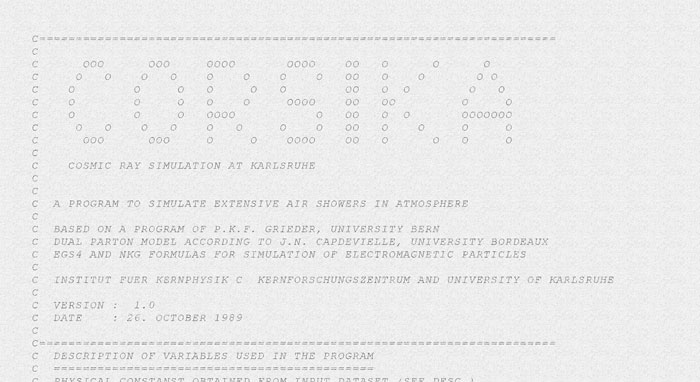 CORSIKA v1.0 was released on Oct. 26, 1989.
CORSIKA v1.0 was released on Oct. 26, 1989.
The air shower simulation program CORSIKA turned 25 years old last October. CORSIKA is a detailed Monte Carlo program to study the evolution and properties of extensive air showers in the atmosphere. Its first version 1.0 was issued on Oct. 26, 1989 and was primarily designed for the requirements of the KASCADE experiment.
In the design phase 1988 of the KASCADE experiment physicists were lacking an adequate cosmic air-shower simulation program. As no well-documented code could be obtained at that time the development of CORSIKA (COsmic Ray SImulation for KAscade) was initiated. The CORSIKA program allows to simulate interactions and decays of nuclei, hadrons, muons, electrons, and photons in the atmosphere. It gives type, energy, location, direction and arrival times of all secondary particles - above a selected - that are created in an air shower.
From the original code of 1989, CORSIKA has then been extended to TeV gamma ray astronomy to be used by high-energy experiments such as the MAGIC telescopes in La Palma and the H.E.S.S. telescopes in Namibia.
Further developments has coupled CORSIKA with other programs to describe hadronic interactions at lower energies and to enable the production of neutrinos, Cherenkov radiation, and radio emission with CoREAS.
In 1996 the upcoming(!) Pierre Auger Observatory required extra special features. To deal with the size of the ultra-high energy cosmic-ray showers, only a so-called thin-sampling of few selected showers are followed and accordingly weighted, while the bulk of particles is dropped to save CPU-time. This thinning has enabled simulations at highest energies within a reasonable time. Numerically solving the differential cascade equations for the different type of particle within a shower was also especially suited for the fluorescence detectors of the Pierre Auger Observatory.
CORSIKA is nowadays used by nearly 1 000 scientists in more than 50 countries and has become a reference program for all experiments dealing with extensive air showers induced by high-energy cosmic rays, gamma rays or neutrinos up to energies of some 100 EeV.
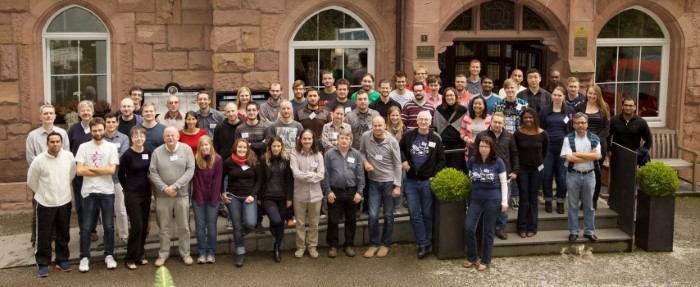 More than 60 participants attended the CORSIKA School 2014 for the 25th anniversary of CORSIKA.
The school is intended to provide PhD students and young researchers the knowledge needed to simulate and understand extensive air showers.
More than 60 participants attended the CORSIKA School 2014 for the 25th anniversary of CORSIKA.
The school is intended to provide PhD students and young researchers the knowledge needed to simulate and understand extensive air showers.
27/11/14 - Gustav-Hertz-Price 2015 for two FACT scientists
|
Thomas Bretz and Daniela Dorner,
awarded for a technological breakthrough in astroparticle physics.
(credits: private / Peter Winandy)
This telescope (First G-APD Cherenkov Telescope) works in the European Northern Observatory at La Palma with a new camera technology
- even during full moons.
(credit: Daniela Dorner)
|
For their outstanding work in the field of experimental astroparticle
physics, the German Physical Society (DPG) has awarded the Gustav Hertz Price 2015 to Thomas Bretz, now at RWTH Aachen, and Daniela Dorner of
the University of Würzburg.
The DPG laudatio outlined their work on the improvement of Cherenkov
telescopes as "an original and pioneering impulse" to astroparticle
physics. Bretz and Dorner achieved this success within the German-Swiss project
FACT (First Geiger-mode avalanche photodiode Cherenkov Telescope), in
which also scientists from TU Dortmund, ETH Zurich and the University
of Geneva participate.
Cherenkov Telescopes for ground-based observations of cosmic gamma rays
were so far based on single-photon detection using photomultiplier
tubes (PMTs). The Cherenkov light from air showers triggered by
cosmic rays entering in the Earth's atmosphere is recorded by the PMT
cameras. Since PMTs show ageing when exposed to strong light and
therefore must be turned off during bright moon phases, data gaps occur
regularly in the observations. Continuous monitoring however is
important especially for astronomical sources of variable brightness.
Active galactic nuclei, for example, show extreme brightness
fluctuations that are important for the understanding of physical
processes in the vicinity of black holes. In order to make progress
here, highly sensitive photosensors were necessary, combining low
voltage power supply and nanosecond time resolution.
The FACT collaboration developed for the first time a Cherenkov
telescope with silicon-based photosensors, an idea primarly given by
Eckart Lorenz from the Max Planck Institute for Physics in Munich.
The camera has 1440 elements
consisting of arrays of avalanche photodiodes in Geiger mode, the
so-called Silicon photomultipliers (SiPMs), and a DRS4 readout
electronics of the Paul Scherrer Institute.
The camera was built at the ETH Zurich and installed in a telescope on
the Canary Island of La Palma, in the observatory on Mt. Roque de los
Muchachos, 2200 meters above sea level.
|
With this camera, even observations during full moon are possible. Bretz succeeded to optimize the camera and trigger design to increase
the sensitivity of the instrument compared to the PMTs used so far.
Whereas the much higher data stream coming from this camera has been
"tamed" by Dorner with databases.
Meticulously they investigated the performance of the camera until they
reached a high consistency of the data through a sophisticated feedback
system.
The two awardees agree: "It's a success of the whole collaboration
that would not have been possible without the committed work of each
collaborator."
All Observations are controlled remotely, and the results are available
in real time on a public website. This provides optimal conditions for
the implementation of "Target of Opportunity" observations and
multifrequency campaigns. The high quality of the data allows for
pioneering approaches of automated data analysis, as currently
developed at TU Dortmund.
Originally intended as a joke by the two awardees, an idea became
reality: Observations with the new system can be controlled via a
smartphone interface. Bretz and Dorner managed to encapsulate and
automatize the complex functionality of the FACT-technique like a Swiss
Army knife.
Thanks to FACT, SiPM cameras are now "proven technology", and they will
be used in future large-scale facilities such as the Cherenkov
Telescope Array (CTA).
Maybe one day, the idea the two price winners had some years ago could
be realised: A network of globally distributed Cherenkov telescopes
that could compensate the data gaps resulting from the Earth's
rotation.
The Gustav-Herz-Price is endowed with 7500 euros and is awarded since
1993 for an outstanding, recently completed work from young physicists.
The award was announced on November 27 and will be presented in March
2015 during the DPG annual meeting in Berlin.
Press release: DPG
13/10/14 - Dark Matter Search gets FUNKy
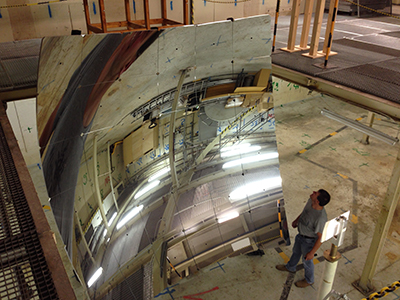
This spare telescope of the Pierre Auger Observatory
will soon be used into the FUNK experiment to hunt for hidden photons.
(credit: Ralph Engel)
What happens when HAP dark-matter physicists meet HAP cosmic-rays physicists at a HAP workshop? They set up
a new experiment! The upcoming experiment FUNK (Finding U(1)'s of a Novel Kind) which aims to measure
"hidden photons", will use a portion of a spherical, metallic mirror which was previously used as a
prototype for the fluorescence telescopes of the Pierre Auger Observatory.
The idea came from a publication of 2012 and was thoroughly discussed during the HAP workshop "Dark Matter: A Light Move" mid-2013.
Scientists from DESY, the Karlsruhe Institute for Technology (KIT) and other institutes in Europe are using
a portion of a spherical, metallic mirror to look for hidden photons.
Hidden photons are candidates for light dark matter.
Unlike WIMPs they would have a small mass and would
interact – albeit very weakly – electromagnetically with normal matter.
Their interaction with electrons would produce regular photons being emitted at right angles to the
conductor's surface – the photon's frequency related to the hidden photons mass.
Using a spherical mirror would concentrate this light at the sphere's centre, where a
receiver could then pick up the dark-matter-generated photons, whereas any background light bouncing off
the mirror will be out of focus.
An ideal mirror for such detection is at hand: a 13 m2 aluminium mirror used in tests during the
construction of the Pierre Auger Observatory and located at the Karlsruhe Institute of Technology. The
newly FUNK collaboration is now readying the mirror. Position of each of its 36 segments has to be
optimized to minimize the spot size of the focused waves. And background radiation within the shielded room
that will house the experiment has to monitored. As for receivers, the most likely option is a set of low-
noise photomultiplier tubes for measurements of visible light, which corresponds to hidden-photon masses of
about 1 eV/C2. Or with more shielding around the experiment a receiver for gigahertz radiation, which
corresponds to masses less than 0.001 eV/C2 is also a possibility.
Depending on the ongoing background studies and performance of the mirror, the DESY/KIT experiment will be
able to operate across quite a broad range of frequencies. And if not the first to search for hidden
photons, FUNK will be one of the first to look for hidden photons as Dark Matter.
More reading: Physics world - Dark matter could light up giant mirror
Publication: Hidden Photon Dark Matter Search with a Large Metallic Mirror, B. Döbrich, K. Daumiller, R. Engel, M. Kowalski, A. Lindner, J. Redondo, M. Roth, Contributed to the 10th Patras Workshop on Axions, WIMPs and WISPs at CERN
22/09/14 - New Findings Relating to Cosmic Rays
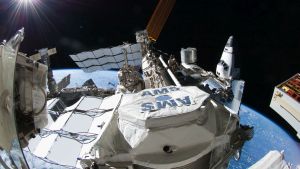
The AMS (Alpha Magnetic Spectrometer) detector on the international space station ISS.
With this particle detector, scientists study the origin and nature of cosmic rays.
(credit: NASA)
Latest results of the measurement of high-energy particles with the AMS detector on the international space station ISS provide for a deeper understanding of the origin and nature of cosmic rays. A young investigator group of Karlsruhe Institute of Technology (KIT), which is headed by Dr. Iris Gebauer, is involved in this experiment. It measured the sum flux of cosmic rays electrons and positrons. The spokesperson of the AMS project, Professor Samuel C. C. Ting, presented the results at the CERN Research Center last week.
High-energy particles reaching the Earth supply important information about the universe. To determine the original composition and energy of these particles, they have to be measured with a detector outside of the atmosphere. This is done by the AMS (Alpha Magnetic Spectrometer) particle detector that was installed on the International Space Station ISS in May 2011. AMS was developed and constructed by more than 500 scientists from 16 countries. It consists of a track detector surrounded by an annular permanent magnet. Due to the magnetic field, charged particles passing the detector are forced to follow circular paths. From their curvature, the scientists can determine the electric charge and energy of the particles.
Researchers of the KIT Institute of Experimental Nuclear Physics (IEKP) under the direction of Professor Wim de Boer participated in the development and construction of several components of the AMS detector. For data analysis, the KIT established the Young Investigator Group (YIG) “Cosmic Ray Transport Models for Dark Matter Searches with AMS-02” in 2011. This group is headed by Dr. Iris Gebauer. It coordinated the measurement of the total flux of electrons – negatively charged elementary particles – and positrons – antiparticles of the electrons of opposite charge -.
The results presented last week by the AMS project spokesperson Professor Samuel C. C. Ting are based on about 41 billion cosmic ray events recorded by the AMS detector in the past three years. About 10 millions of these events were identified to be electrons and positrons. The AMS detector measured the positron fraction, that is the ratio of the number of positrons measured to the total number of positrons and electrons, in the energy range of 0.5 to 500 giga-electron-volts (GeV). From an energy of 8 GeV, this fraction starts to increase quickly. For the first time now, the fraction was found to reach a maximum at about 275 GeV and then, it starts to decrease again. These results indicate the existence of a new source of positrons. “Collisions of dark matter particles can produce an excess of positrons,” explains Dr. Iris Gebauer, KIT. “However, positrons might also be produced by astrophysical point sources, such as pulsars, i.e. quickly rotating neutron stars.”
The researchers also used the AMS particle detector to precisely measure the electron and positron flux. This means that they determined the intensities of electrons and positrons in cosmic rays. For the first time, the measurements quantitatively revealed how much electrons and positrons differ in energy dependence and flux intensity. In the range between 20 and 200 GeV, the rate of change of the positron flux was surprisingly higher than that of the electron flux. This shows that the excess of the positron fraction is due to a relative excess of high-energy positrons that are expected to result from dark matter collisions or pulsars and not to the relative loss or the relative decrease of high-energy electrons. These observations prove the fundamental difference between electrons and positrons, i.e. matter and antimatter.
AMS measurement of the combined flux of electrons and positrons by the YIG of Dr. Iris Gebauer in cooperation with scientists of the Istituto Nazionale di Fisica Nucleare (INFN), Perugia/Italy, indicates the total intensity of both types of particles. “It is the most precise measurement of the electron and positron flux so far and determines the radiation flux up to energies of 1000 GeV with highest accuracy,” Gebauer reports. “Compared to the measurement of the positron flux, the energy range is doubled.” Now, the researchers can use a precision detector of 4 m in size to measure energy ranges in space that can also be accessed by large air shower experiments on the Earth’s surface. This is important for understanding cosmic rays and their sources. “Earlier experiments discovered structures in the total flux at 300 to 800 GeV, which indicated new physical effects. Our measurement shows that the total flux of electrons and positrons up to energies of 1000 GeV exhibits a smooth behavior that can be explained by an additional component of high-energy positrons,” the Head of the YIG explains.
Future measurements with the AMS detector are planned to find out whether the observed excess of positrons really results from the existence of dark matter or from astrophysical point sources. For this purpose, the YIG scientists under the direction of Dr. Iris Gebauer measure the directional dependence of high-energy positrons. “Dark matter is widely distributed, a point source is located at a certain point,” Gebauer explains.
The new results of the AMS experiment were published in the Physical Review Letters (113, 121102 – September 18, 2014).
Press release: KIT
Publication: Electron and Positron Fluxes in Primary Cosmic Rays Measured with the Alpha Magnetic Spectrometer on the International Space Station, M. Aguilar et al. (AMS Collaboration), Phys. Rev. Lett. 113, 121102 (2014)
27/08/2014 - The Sun as Borexino Sees It in Real Time
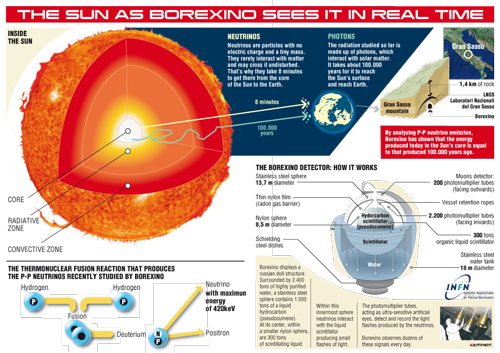
The neutrino experiment Borexino in the INFN Gran Sasso Laboratories has managed to measure the energy of our star in real time: the energy released today at the centre of the Sun is exactly the same as that produced 100,000 years ago.
For the first time in the history of scientific investigation of our star, solar energy has been measured at the very moment of its generation. This has been announced by the Borexino experiment at the Gran Sasso National Laboratories (LNGS) of the Italian National Institute for Nuclear Physics (INFN). The study is published on August 28th, 2014 in the prestigious international journal Nature.
Borexino has managed to measure the Sun’s energy in real-time, detecting the neutrinos produced by nuclear reactions inside the solar mass: these particles, in fact, take only a few seconds to escape from it and eight minutes to reach us. Previous measurements of solar energy, on the other hand, have always taken place on radiation (photons) which currently illuminate and heat the Earth and which refer to the same nuclear reactions, but which took place over a hundred thousand years ago: this, in fact, is the time it takes, on average, for the energy to travel through the dense solar matter and reach its surface. The comparison between the neutrino measurement now published by Borexino and the previous measurements concerning the emission of radiant energy from the Sun shows that solar activity has not changed in the last one hundred thousand years. "Thanks to the results of this new Borexino research we have seen, via the neutrinos produced in the proton-proton (pp) reaction, that it is the chain of pp nuclear fusions which makes the Sun work, providing precisely the energy that we measure with photons: in short, this proves that the Sun is an enormous nuclear fusion plant," says Gianpaolo Bellini, one of the fathers of the Borexino experiment.
The Borexino detector, installed in the INFN underground Laboratories of Gran Sasso, has managed to measure the flux of neutrinos produced inside the Sun in the fusion reaction of two hydrogen nuclei to form a deuterium nucleus: this is the seed reaction of the nuclear fusion cycle which produces about 99% of the solar energy. Up until now, Borexino had managed to measure the neutrinos from nuclear reactions that were part of the chain originated by this reaction or belonging to secondary chains, which contribute significantly less to the generation of solar energy, but which were key to the discovery of certain crucial physical properties of this "ephemeral" elementary particle, the neutrino.
The difficulty of the measurement just made is due to the extremely reduced energy of these neutrinos (they have, in fact, a maximum energy of 420 keV), the smallest one compared to the other neutrinos emitted by the Sun, which also have energy levels so low as to make it almost impossible to measure them and which only Borexino was and is able to measure. This performance makes Borexino a detector unique in the world, and it will remain so for a number of years, thanks to state-of-the-art technologies used in its construction, which have allowed not only the neutrinos emitted from the Sun but also those produced by our Earth to be studied.
BOREXINO
|
The Borexino experiment is installed in the Italian Gran Sasso underground laboratory approximately 1400 meters beneath the surface of the Earth and serves primarily for the observation of neutrinos. Borexino is a cooperation of scientists from Italy, Germany, France, Poland, USA and Russia. Germany is represented with groups from Technische Universität München (TUM), the Max-Planck Institute for Nuclear Physics in Heidelberg (MPIK), the Universty of Mainz, the University of Hamburg, and the Technische Universität Dresden. One of the Authors and co-initiator of the Borexino Experiment is TUM Professor Emeritus and HAP Senior Fellow Franz von Feilitzsch, who founded the Collaborative Research Center "Astrophysics" in 1994 in which the Borexino Experiment assumed a central role.
|
Press release: INFN,
TUM
Publication: Neutrinos from the primary proton–proton fusion process in the Sun,
Borexino Collab., Nature 512, 383–386 (2014)
More reading: Nature - News: Long-sought neutrinos answer burning question about the Sun,
More reading: Nature - News & Views: Neutrino physics: What makes the Sun shine",
11/04/14 - Gamma-ray Astronomy: Site negotiations for Cherenkov Telescope Array started

On the 10th April 2014, the 12 country delegates mandated by their governments to decide about the start of site negotiations for CTA met in Munich. They took note of the report of the international Site Selection Committee (SSC) and thanked the members of the SSC as well as the CTA consortium for their extensive inputs on the merits of the proposed sites.
The delegates representing Argentina, Austria, Brazil, France, Germany, Italy, Namibia, Poland, Spain, South Africa, Switzerland and the UK decided, based on the 75% majority required, to start the negotiations on the two sites in the southern hemisphere, namely Aar in Namibia and ESO (European Southern Observatory) in Chile, keeping Leoncito in Argentina as a third option. After negotiations finally one site will be selected at the end of the year. With the selection of the potential telescope sites in the southern hemisphere an important step towards the realization of the international Cherenkov Telescope Array has been made.
As far as the northern site of the CTA Observatory is concerned – candidate sites are located in Mexico, Spain and the USA - further considerations are necessary.Therefore, the delegates decided to postpone their decision and to ask the CTA board of agency representatives – the Resource Board - to take this forward.The decision for the negotiations about the northern hemisphere site will be taken as soon as possible.
“We are very happy that this important step has been reached” said B. Vierkorn-Rudolph, chair of the CTA Resource Board. “CTA will be a unique large-scale infrastructure for astronomy - with this decision we now can start the negotiations with the potential site countries in the southern hemisphere and advance the implementation of CTA”. The spokesperson of the CTA Consortium, Professor Werner Hofmann said “The site choice is on the critical path towards implementing CTA; this decision represents a major step forward and we appreciate very much the engagement and support of the funding agencies and the country delegates involved in the decision”.
CTA
|
CTA – the Cherenkov Telescope Array – is a multinational, world-wide project to construct a unique instrument exploring the cosmos at the highest photon energies. Over 1,000 scientists and engineers from 5 continents, 28 countries and over 170 research institutes participate in the CTA project. CTA will provide an order-of-magnitude jump in sensitivity over current instruments, providing novel insights into some of the most extreme processes in the Universe.
CTA will consist of over 100 Cherenkov telescopes of 23-m, 12-m and 4-m dish size located at one site in the southern and a smaller site in the northern hemisphere. Potential candidate sites have been identified in the northern and southern hemisphere. Extensive studies of the environmental conditions, simulations of the science performance and assessments of costs of construction were conducted. The Site Selection Committee, composed of international experts in the evaluation of sites for astronomical observatories, has reviewed the studies and provided an independent assessment of the various candidate sites.
|
Press release: CTA, Symmetry Magazine
03/04/14 - DPG awards Hertha Sponer Prize to Anne Schukraft (RWTH Aachen)
|


Dr. Anne Schukraft (middle) receives the Hertha Sponer
Prize of the German Society of Physics in Berlin
for her PhD thesis
at RWTH Aachen.
(Bild: RWTH Aachen)
|
|
Every year, the "Deutsche Physikalische Gesellschaft" (DPG - German Society of Physics) distinguishes with the Hertha Sponer Prize young female physicists for their outstanding scientific work. In 2014 Dr. Anne Schukraft of RWTH Aachen received the distinction for her PhD thesis, which has delivered a significantly improved understanding of systematic errors and a significant increase in the experimental sensitivity of IceCube. IceCube is the largest neutrino telescope in the world, which captures traces of neutrinos from outer space at the South Pole. The prize was presented at a special ceremony of the German Society of Physics in Berlin.
Dr. Schukraft has paved the way for the discovery of high-energy neutrinos of cosmic origin with the so far most accurate measurement of muon neutrinos. This is one of the biggest challenges of astroparticle physics. With their discovery in the IceCube experiment a new observation window of the universe is opened with the possibility to finally solve the more than 100 year-old mystery of the origin of cosmic rays
The Hertha Sponer Prize is name so in honor of the great German physicist Hertha Sponer (1895 – 1968), who in 1920 was one of the first German women to receive a PhD in physics. The prize consists of a prize of 3 000 euros and is primarily intended to support young scientists and to attract more women in physics.
Presse release: RWTH Aachen
|
27/03/14 - Senior Fellows of the Helmholtz Alliance for Astroparticle Physics in Mainz
|
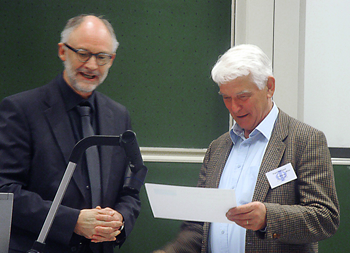
|
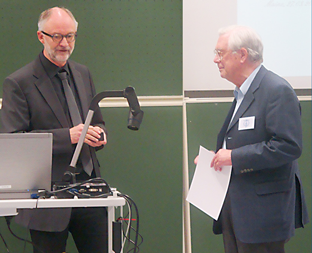
|
|
Left: Prof. Dr. Blümer (HAP spokesperson) and Prof. Dr. von Feilitzsch, Right: Prof. Dr. Blümer and Prof. Dr. Schatz,
Unfortunately Prof. Dr. Völk could not make it to the ceremony.
(credit: HAP/B.v.Puttkamer)
|
The Helmholtz Alliance for Astroparticle Physics has awarded the title of Senior Fellow of the Helmholtz Alliance for Astroparticle Physics in 2013 to:
- Prof. Dr. Franz von Feilitzsch (TU München),
- Dr. Gerd Schatz (KIT) und
- Prof. Dr. Heinrich J. Völk (MPIK Heidelberg)
The ceremony took place at the beginning of the Member Meeting of the 'Fachverband Teilchenphysik' of DPG at the Johannes Gutenberg University Mainz on 2014, March 27.
The three retired scientists are awarded a Senior Fellowship, travel funds for conferences and schools associated with HAP as well as funding opportunities for scientific projects. Thus, the recognized scientists can continue to be involved in current research and to share their experience and knowledge within the Alliance.
More pictures here
21/03/14 - 2013 Senior Fellows of the Helmholtz Alliance for Astroparticle Physics
|
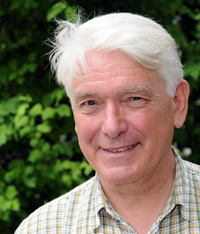 |
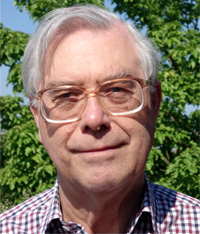
|
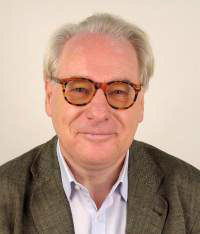
|
|
The three Senior Fellows 2013: Franz von Feilitzsch, Gerd Schatz and Heinrich J. Völk.
(credit: private)
|
The Helmholtz Alliance for Astroparticle Physics had awarded its Senior Fellow status to three more colleagues in 2013: Franz von Feilitzsch, Gerd Schatz and Heinrich J. Völk. We have now identified the time and location to physically give our appreciation to the awardees:
Thursday, March 27, 19:30 at the Johannes Gutenberg University Mainz
at the beginning of the Member Meeting of the 'Fachverband Teilchenphysik' of the DPG.
We cordially invite you to attend!
07/03/14 - Beautiful timelapse of the Pierre Auger Observatory
More about the Pierre Auger Observatory: A documentary produced by Hyperraum.TV, featuring Auger scientists and one of the project managers Dr. J. Kleinfeller - [DE] Weltraumteilchen im Wassertank
13/01/14 - What pulls the Milky Way through space?

The universe at a distance of up to a billion light-years from Earth.
The Shapley Supercluster is to the right of the Milky Way.
(credit: R. Powell)
The Local Group of which our Milky Way is a part, travels with about two million kilometers per hour through space. Scientists are still debating the cause of this cosmic frenzy. An international collaboration of researchers from the US, France, Australia and China and the University of Bonn finds evidence that the giant Shapley Supercluster can not be solely responsible but that there should be another huge gravitational attractor further out, bringing the Local Group up to speed.
The Local Group is a group of galaxies that includes the Andromeda Galaxy, the Triangulum Galaxy ( M33 ), other smaller galaxies as well as the Milky Way. "The reason for the high speed and the cause of the direction of their movements are not explained conclusively so far," says Marek Kowalski of the University of Bonn. The research team has followed a new approach to better understand the sources for the motion of the Local Group.
Within the framework of the Nearby Supernova Factory project, the research team took more than 100 observations of Supernovae of type Ia with the 2.2-meter telescope of the University of Hawaii on the summit of the Mauna Kea volcano. The researchers used it as a kind of lighthouses in space: "On the basis of their brightness, we can determine the distance to the supernovae and the speed with which they move away or towards us," explains Marek Kowalski.
Like an onion, the researchers divided the sky of the Earth in individual spherical shells. Depending of the supernovae that lied in each shell, they determined the speed and the direction of movement of these subspaces. "Our hypothesis was that the attraction of a gigantic mass is the cause of the motion of the Local Group and the shells", says Ulrich Feindt, a PhD student of Kowalski and first author of the study. In the predominant direction in which the Local Group hurtles thourgh the Universe stands the Shapley Supercluster (SCI 124), the largest concentration of galaxies in our nearby universe at a distance of 650 million light years to the Milky Way.
"Our data showed, however, that the gravity of the Shapley supercluster is not sufficient to explain the velocity of the Local Group as well as the profile of our shells," says Feindt. "We would have to add a second object of approximately the same mass to obtain the required attraction." The scientists suspect that this enigmatic gigantic mass could be a loose collection of different galaxies, the so-called Sloan Great Wall. The gravitational attraction of this agglomeration of Galaxies together with that of the Shapley Supercluster could explain the speed and the direction of motion of the Local Group according to the findings of the researchers.
This study is the most comprehensive one on the subject. The international collaboration of researchers used Supernova data, which extends about twice as far as that of previous work on the subject and hence enabled the new findings.
Press release: U. Bonn / DE in pro-physik.de
Publication: Measuring cosmic bulk flows with Type Ia Supernovae from the Nearby Supernova Factory,
U. Feindt et al., A&A 560, A90 (2013)



.jpg)
.jpg)










